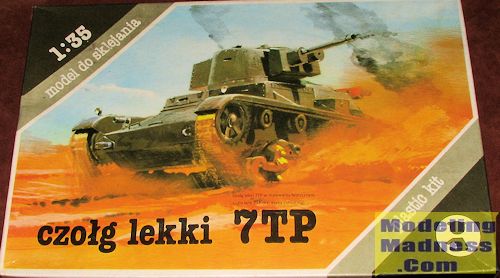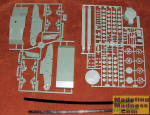
| KIT #: | ? |
| PRICE: | I paid $19.95 |
| DECALS: | Two options |
| REVIEWER: | Scott Van Aken |
| NOTES: |

| HISTORY |
The 7TP was the Polish development of the British Vickers 6-ton Mark E tank licence. Comparing to Vickers, the main new features of 7TP were: a better, more reliable and powerful diesel engine, a 37 mm anti-tank gun, thicker armour (17 mm instead of 13 mm on the front), modified ventilation, the Gundlach tank periscope, and a radio. About 132 tanks were produced between 1935 and the outbreak of the war, plus four iron prototypes. The designation 7TP meant "7 Tonne, Polish" (in fact its weight increased to 9 tonnes after the initial prototype).
Although 7TP is often claimed to be the world's first (production) diesel-powered tank, this distinction actually goes to Japanese Type 89B I-Go Otsu, produced with a diesel engine from 1934 onwards. Barring that, the claim of a first purpose-designed diesel-powered tank is tied with Type 95 Ha-Go, whose series production also commenced in 1935. The diesel oil used as fuel had an important advantage of being much less flammable than gasoline.
Like its British predecessor, the 7TP was initially produced in two variants: twin turret version armed with 2 Ckm wz.30 machine guns, and a single turret version, armed with 37 mm Bofors wz. 37 gun. After initial tests, it became clear that the twin-turret variant was obsolete and lacked firepower, so it was abandoned in favour of the more modern single turret design.
Prior to the outbreak of World War II most of the twin turret tanks were converted to single turret versions and only 24 twin-turret types remained in Polish service (as opposed to roughly 108 of the other type). It is to be noted that twin and single turret variants had no specific designations. In some modern books they are unofficially designated "7TP dw." and "7TP jw." (Polish abbreviations for dwuwieżowy – dual turreted; jednowieżowy – single turreted).
In 1938 Państwowe Zakłady Inżynierii also produced 13 prototype models of a better armored version of the 7TP – the 9TP. Although the 9TP never entered production, these prototypes were used in the defense of Warsaw in September 1939.
| THE KIT |
 After
reading an Osprey book comparing this tank with the Panzer II, I started
looking for a kit of this and found one at the LHS. I was somewhat familiar
with Spojnia, having built their LWS XIIIter kit a couple of decades back.
The kit comes on two bluish-grey sprues with 'rubber band' type vinyl
tracks.
After
reading an Osprey book comparing this tank with the Panzer II, I started
looking for a kit of this and found one at the LHS. I was somewhat familiar
with Spojnia, having built their LWS XIIIter kit a couple of decades back.
The kit comes on two bluish-grey sprues with 'rubber band' type vinyl
tracks.
The molding of the kit is actually quite good without any flash though I did spot several sink areas on thicker pieces. Ejector pin marks seem to be limited to the inside of big items. The kit is a curbside without any interior detailing. Likewise, all the hatches are molded closed. The hull is made up of a lower section with two side pieces. The suspension bits are rather complex and I'd say that a good 70% of the kit's parts count is related to these.
The sprocket, return rollers and suspension bits are held in place by caps on the inside so are supposed to move. The main gun is also supposed to be able to be elevated, while the turret base, a separate piece from the turret, is also held on by a cap on the inside. On the upper hull are fender braces, stowage boxes and the usual tow hooks and handles.
Instructions consist of a large, single sheet that is folded. On one side are the nicely drawn construction steps while on the other is a history section (in English) and a painting guide. There are decals for two tanks. One an overall green while the other is in a disruptive pattern of sand, olive green and dark brown. There are turret markings on a decal sheet, but since the small sheet has white markings on a white background it will be impossible to show these to you.
| REFERENCES |
| REFERENCES |
http://en.wikipedia.org/wiki/7TP
May 2015
Thanks to me
for the preview kit. If you would like your product reviewed fairly and fairly quickly, please
contact the editor or see other details in the
Note to
Contributors.